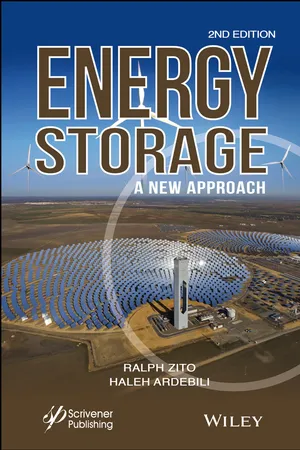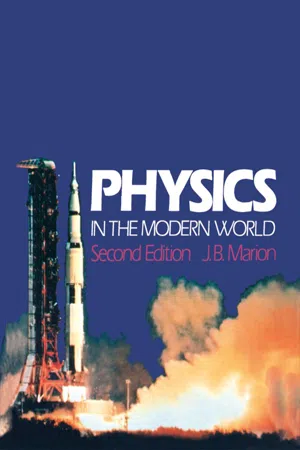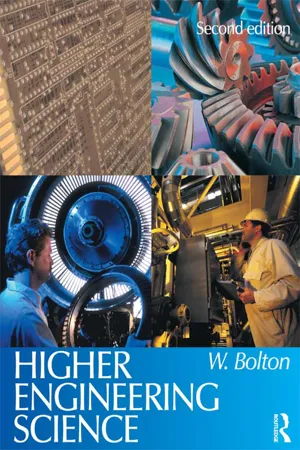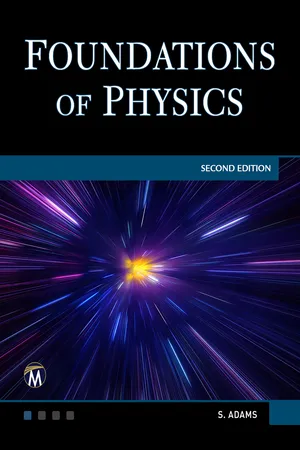Physics
Force Energy
Force energy refers to the energy associated with an object's motion or position, which can result in the application of force to another object. It is a form of potential energy that is converted into kinetic energy when an object is in motion. In physics, force energy is a fundamental concept used to explain the behavior of objects in motion and at rest.
Written by Perlego with AI-assistance
Related key terms
11 Key excerpts on "Force Energy"
- eBook - ePub
Energy Storage
A New Approach
- Ralph Zito, Haleh Ardebili(Authors)
- 2019(Publication Date)
- Wiley-Scrivener(Publisher)
The history of the development of physical concepts is not the prime concern here, but some knowledge of their evolution does serve to bring more closely to our attention and scrutiny a better appreciation of terms that we employ daily. Sometimes it is necessary to begin understanding or developing a body of knowledge in order to make certain basic assumptions on an entirely intuitive basis. As scientifically unsatisfying as that may be, it is unavoidable at times. One could draw a weak comparison to plane geometry (Euclid) with regard to its various axioms and the declaration that parallel lines never meet. Even the concept of straight lines is rather intuitive in nature.Perhaps the best definition is that a force is required to change the motion of a body. Many problems arise in finding acceptable definitions for the basic parameters of physical science, namely, the abstract concepts of mass, time, force, and energy. However, we must learn to be satisfied with definitions that leave something to be desired in order to move on toward generating a working body of mechanics that enables us to design and build practical devices that serve our purposes.An interesting definition of energy comes from the Grolier Encyclopedia, which states:Energy can be measured in terms of mechanical work, but because not all forms of energy can be converted into useful work, it is more precise to say that the energy of a system changes by an amount equal to the net work done on the system … In classical physics, energy, like work, is considered a scalar quantity; the units of energy are the same as those of work. These units may be ergs, joules, watt-hours, foot-pounds, or foot-poundals, depending on the system of units being used. In modern science, energy and the three components of linear momentum are thought of as different aspects of a single four-dimensional vector quantity, much as time is considered to be one aspect of the four-dimensional space-time continuum … Energy exists in many different forms. The form that bodies in motion possess is called kinetic energy. Energy may be stored in the form of potential energy, as it is in a compressed spring. Chemical systems possess internal energy, which can be converted by various devices into useful work; for example, a fuel such as gasoline can be burned in an engine to propel a vehicle. Heat energy may be absorbed or released when the internal energy of a system changes while work is done on or by the system. (1993) - eBook - ePub
- Max Jammer(Author)
- 2012(Publication Date)
- Dover Publications(Publisher)
581 Statics thus viewed is a particular branch of dynamics, namely, the theory of the equilibrium of forces. Thus, the conception of force as outlined previously can be carried over to statics as well.Modern physics recognizes the concept of force in both statics and dynamics, and thereby in every other field of physics as far as motive forces are concerned, as a methodological intermediate that in itself carries no explanatory power whatever. It is a construct to which no immediate rule of interpretation or epistemic correlation can be attached; only a long chain of logical relations, leading over the concepts of mass and acceleration, themselves complicated constructs, refers it to the data of sensory experience. In recognition of the highly abstract character of the concept of force, modern physics saw some justification in modifying its logical status and considering it as based on the concept of work or energy. In fact, it is often claimed that the concept of work or energy has a more decisive and fundamental role in present-day physics than that of force, and in usurping the concept of force by energy, only more justice is done to the physical nature of force. In consequence of considerations such as these, force is defined as the space rate of change of energy: The vectorial components f n of a force in an n -dimensional coordinate system mapped out by the vectors x 1 , x 2 , . . . ,x n are those numbers f n which determine how much work is performed during each of the virtual displacements x n of its point of application. If an arbitrary displacement r = r 1 x 1 + r 2 x 2 + . . . + r n x n is given, the work performed is equal to . In short, force is a covariant vector (f 1 , f 2 , . . . , f n ) satisfying the equationor an equivalent equation involving the use of the integral.This definition corresponds to the more abstract treatment of these concepts in modern theoretical mechanics. Here (ordinary) forces may be considered as particular cases of the so-called “generalized forces Q k .” If in Lagrange’s equations of the second kind the coordinates q k , in the expressions Q k δq k of the right-hand side, have the meaning of length, the coefficients Q k - eBook - ePub
- A. L. Stanford, J. M. Tanner(Authors)
- 2014(Publication Date)
- Academic Press(Publisher)
5Work, Power, and Energy
Publisher Summary
This chapter discusses physical quantities and concepts necessary for the understanding of energy and its associated conservation principle. In the nonscientific world, work is often thought of in terms of some physical or mental effort. In physics, however, the term work is defined precisely. Doing work requires the use of force, and work on a body does not take place without displacement of that body. The rate at which work is done is often of interest in practical applications. Power is the measure of the rate at which work is being done. It is sometimes convenient to express power in terms of a constant force acting on an object moving at a constant velocity. A unit commonly used for measuring electrical power is the kilowatt . A particle or a system of particles that has the capacity to do work is said to possess energy, a physical quantity associated with the particle or system that may take many forms. In the technical sense, however, a system that has the ability to do work is said to have energy. Energy is a scalar quantity that is usually expressed in terms of the same units as those of work.This chapter introduces one of the most important and perhaps the most far-reaching of all principles in the sciences—the conservation of energy. A conservation principle is a rule or a natural law that specifies that the value of a physical quantity does not change during the course of a physical process but remains constant. The quantity that does not change is said to be conserved. The simplicity of conservation principles makes them concise expressions of natural law and powerful tools of scientific analysis. Conservation of energy is only one of a number of conservation principles that students of science or engineering will encounter. The significance and the usefulness of these principles should become apparent to the student as they are used to analyze and interpret physical phenomena. - No longer available |Learn more
- Robert A. Pelcovits, Joshua Farkas(Authors)
- 2023(Publication Date)
- Barrons Educational Services(Publisher)
4Work, Energy, and Power
Learning Objectives
In this chapter, you will learn:Definition of work, kinetic and potential energy, and powerWork-energy theoremConservative and nonconservative forcesHooke’s law and elastic potential energyConservation of mechanical energyEnergy diagramsWork
The work done on a body by a single external force F is defined by the equationThe definition of work by one forceWhat if n external forces are acting on an object at the same time? Because of the principle of superposition of forces, the net work isWork due to multiple forcesWhen this expression is expanded, we find that the net work is equal to the algebraic sum of the work done by each individual force. (Recall that A · B + C · B = (A + C) · B.)Work due to multiple forcesThus, to calculate the net work done by multiple forces, we can (1) calculate the work done by each force and sum these individual works, or (2) calculate the net force and compute the work done by the net force using the equation dW = Fnet · dr.Work (and energy) has units of newton · meter, which is defined to be a joule (J = N · m = kg·m2 /s2 ).Because work is equal to the dot product of the net force and the displacement vector, it is a scalar whose magnitude and sign are determined by the component of the net force parallel to the direction of motion. This can be shown explicitly by resolving the force into components parallel and perpendicular to the displacement vector and expanding the dot product:There are three sign possibilities for work, which correspond to the three different situations discussed below. This following discussion can be understood based on the fact that the displacement vector dr is parallel to the velocity and on our discussion of tangential acceleration (which affects an object’s speed) and centripetal acceleration (which affects an object’s direction) from Chapter 2 - eBook - ePub
Biomechanics of Human Motion
Applications in the Martial Arts, Second Edition
- Emeric Arus, Ph.D.(Authors)
- 2017(Publication Date)
- CRC Press(Publisher)
In our daily life, we often hear talk about energy. Do you say to yourself “I have no energy to finish the job or I need more energy to be able to reach a destination when you are walking on a hill?” The energy is the ability to do work.It is difficult to define energy in precise terms of shape, mass, or size. Rather, the energy suggests a dynamic state related to a condition of change because the presence of energy is revealed only when a change has taken place.There are two kinds of energy: potential and kinetic energy. The potential energy is a stored energy in a body or system. The kinetic energy can be described as the capacity to do work by virtue of the body’s motion. Where is a motion, such as a wind blow, a waterfall, a karateka kick, or the chemical composition of a body with its atoms and molecules that are in motion, there is a kinetic energy (e.g., heat energy). The kinetic energy comes from the potential (stored) energy.We know that there are many different kinds of energy such as chemical, electrical, light, wind, thermonuclear, water, and mechanical energy. According to the law of thermodynamics (conservation of energy ), which states that in any system not involving nuclear reactions or velocities approaching the velocity of light, energy cannot be created or destroyed but can be lost. An athlete can lose or deplete his energy if he does not adequately supply it by means of meal, drink, or rest.Let us analyze the potential energy a little bit more, noted with PE or U . U also represents work. We can see or realize that when an object has been moved to a certain distance and it has the tendency to return to its original position due to a force, which is also often called a restoring force , it represents a stored energy called the potential energy. For example, a stretched spring has the tendency to return to its original position due to potential energy. Another example is that when a weight is lifted up to a certain height, the force of gravity will try to bring it back to its original position due to the gravitational potential energy. - eBook - ePub
- Jerry Marion(Author)
- 2012(Publication Date)
- Academic Press(Publisher)
movement . To make use of the potential energy possessed by an object, the potential energy must first be converted into motional energy. If we drop an object from a certain height, we know that it will accelerate due to gravity and will strike the floor with a certain velocity. The greater the height from which the object is dropped, the greater will be its impact velocity and the greater will be the kinetic energy and the amount of work that can be done.We can define the energy concept in the following way:Energy is the capacity to do work.The potential energy of a raised block, Mgh , can be converted into an equal amount of work. The potential energy is first converted into kinetic energy, Mv 2 = Mgh , and the kinetic energy is then converted into work by driving the stake into the ground. The net result of the operation is to use the original amount of potential energy to drive the stake.Conservation of Energy—Forms of Energy
In the example of the falling block, no energy is lost in any phase of the process. Work is done on the block and the block possesses this amount of energy—in the form of potential and/or kinetic energy—until the energy is given up when the block does an equivalent amount of work on the stake. The energy delivered to the stake is finally converted into heat and sound energy. Although energy is converted from one form to another, no energy is lost—energy is conserved . This important concept is summarized by the equation(7-14)E initial=E final=( K .E . + P .E . )initial( K .E . + P .E . )final(7-14)Every process known in Nature takes place in accordance with the principle of energy conservation. But the true importance of this principle cannot be fully understood or appreciated unless it is realized that energy appears in many forms. If we add up all of the energy in its various forms that an isolated system possesses before an event or process takes place and do the same afterward, we always find an exact balance. We can make this calculation only if we know all of the ways in which energy can appear. If we did not realize the existence of electric energy, for example, we would discover many situations in which there is an apparent increase or decrease in energy. - eBook - ePub
- James Bobick, Naomi E. Balaban(Authors)
- 2019(Publication Date)
- Visible Ink Press(Publisher)
Physicists define energy as the capacity to do work. Work is defined as the force required to move an object some distance. Examples of the different kinds of energy are thermal (heat) energy, light (radiant) energy, mechanical energy, electrical energy, and nuclear energy. The law of the conservation of energy states that within an isolated system, energy may be transformed from one form to another, but it cannot be created nor can it be destroyed.What are the two forms of energy?The two forms of energy are kinetic (working) energy and potential (stored) energy. Kinetic energy is the energy possessed by an object as a result of its motion, while potential energy is the energy possessed (stored) by an object as a result of its position. As an example, a ball sitting on top of a fence has potential energy. When the ball falls off the fence, it has kinetic energy. The potential energy is transformed into kinetic energy. Some examples of different forms of energy are:•Chemical energy is a form of potential energy. It is the energy stored in the bonds of atoms and molecules. Some examples of chemical energy are batteries, biomass, petroleum, natural gas, and coal. •Mechanical energy is also a form of potential energy. It is stored in objects by tension. Examples of mechanical energy are compressed springs and stretched rubber bands. •Nuclear energy is energy stored in the nucleus of an atom. Large amounts of energy may be released when the nuclei are combined or split apart. Nuclear energy is a form of potential energy.•Gravitational energy is energy stored in an object’s height. The higher and heavier the object, the more gravitational energy is stored. As an object goes down a hill and picks up speed, the gravitational energy is converted to motion energy. Gravitational energy is also a form of potential energy.•Radiant energy is electromagnetic energy that travels in transverse waves. Light and sunshine are examples of radiant energy. It is a form of kinetic energy. - eBook - ePub
Newtonian Dynamics
An Introduction
- Richard Fitzpatrick(Author)
- 2021(Publication Date)
- CRC Press(Publisher)
CHAPTER 5 Conservation of Energy DOI: 10.1201/9781003198642-5 5.1 Introduction Nowadays, the conservation of energy is undoubtedly the single most important idea in physics. Strangely enough, although the basic idea of energy conservation was familiar to scientists from the time of Newton onward, this crucial concept only moved to center stage in physics in about 1850 (i.e., when scientists first realized that heat was a form of energy). According to the ideas of modern physics, energy is the fundamental substance that makes up all things in the universe. Energy can take many different forms; for instance, potential energy, kinetic energy, electrical energy, thermal energy, chemical energy, nuclear energy, etcetera. In fact, everything that we observe in the world around us represents one of the multitudinous manifestations of energy. There exist processes in the universe that transform energy from one form into another; for instance, mechanical processes (which are the focus of this book), thermal processes, electrical processes, nuclear processes, etcetera. However, all of these processes leave the total amount of energy in the universe invariant. In other words, whenever, and however, energy is transformed from one form into another, it is always conserved. For a closed system (i.e., a system that does not exchange energy with the rest of the universe), the previous law of universal energy conservation implies that the total energy of the system in question must remain constant in time. 5.2 Energy Conservation During Free-Fall Consider a mass, m, that is falling vertically under the influence of gravity. We already know how to analyze the motion of such a mass. Let us employ this knowledge to search for an expression for the conserved energy during this process. (Note that this is clearly an example of a closed system, involving only the mass and the gravitational field.) The physics of free-fall under gravity is summarized by the three equations (2.16)–(2.18) - eBook - ePub
- William Bolton(Author)
- 2012(Publication Date)
- Routledge(Publisher)
5 Energy transfer5.1 IntroductionThis chapter is concerned with the energy transfers that can occur with mechanical systems. Energy can be transferred from one form to another by work being done or by heat transfer. Here we restrict the discussion to transfers involving work. There are many forms that energy can take and in this chapter potential energy, linear and angular kinetic energy and strain energy are discussed and the principles applied to the solution of mechanical system problems.5.1.1 Conservation of energyThere is a basic principle that is used in all discussions of energy and that is that energy is never lost, it is only transformed from one form to another or transferred from one object to another. This is the principle of the conservation of energy. In any process we never increase the total amount of energy, all we do is transform it from one form to another.5.2 WorkThe principle of the conservation of energy is that energy is never created or lost but only converted from one form to another. In all such conversions, the total amount of energy remains constant.Work is said to be done when the energy transfer takes place as a result of a force pushing something through a distance (Figure 5.1 ), the amount of energy transferred W being the product of the force F and the displacement s of the point of application of the force in the direction of the force.Figure 5.1 WorkWith force in newtons and distance in metres, the unit of work is the joule (J) with 1 J being 1 N m.Work done by a constant force W = Fs [1] Consider the work done by a force F when the resulting displacement s is at some angle 0 to the force (Figure 5.2 ). We can look at this in two equivalent ways. We can consider the displacement in the direction of the force F is s cos θ and so the work done is:work done = F × s cos θ [2] Figure 5.2 An oblique forceAlternatively, we can consider the force component acting in the direction of the displacement. The force can be resolved into two components, namely F cos θ in the direction of the displacement and F sin θ at right angles to it. There is no displacement in the direction of the F sin θ component and so it does no work. Hence the work done by the oblique force is solely due to the F cos θ - eBook - ePub
- Steve Adams(Author)
- 2023(Publication Date)
- Mercury Learning and Information(Publisher)
If a mass is moved around a closed loop inside a gravitational field (any gravitational field, not just a uniform field) the work done by an external agent in lifting it is equal to the work done by the gravitational field as it comes back down. If it is returned to its original position the work done in the loop is zero. This is an example of what is called a “conservative field.” Gravitational fields are conservative fields.5.3.3 Kinetic EnergyKinetic energy is the energy a body has because of its motion. We can use the definition of work to derive an expression for kinetic energy by considering the work that must be done to accelerate a mass m from velocity u to velocity υ .Consider a mass moving at velocity υ and acted upon by a resultant force FIn a short time δ t the work done on the mass is given by: δ W = F δ s = Fυ δ tUsing:Taking the limit of δ t → 0 and integrating between initial and final velocities gives:The work done is equal to the change in kinetic energy so: KE = ½ mυ 2It is also possible to derive this relationship by considering a constant resultant force acting on a constant mass to produce a constant acceleration. The displacement during acceleration is given by:Multiplying throughout by the mass m and acceleration a gives:Using F = ma we obtain: W = Fs = ½ mυ 2 - ½ mu 2 as before.5.3.4 The Law of Conservation of EnergyThe law of conservation of energy can be stated in several different ways. Here are two of them:Energy is never created or destroyed but one form can be transferred to another.The total energy of a closed system is constant.Energy is a scalar quantity so working out how much energy is present in a system is simply a matter of adding the energies of each part of the system. Alpha decay is a good example. We have already seen that the total momentum of the system is zero before and after the decay. However, nuclear energy has been transferred to the kinetic energy of the new nucleus formed in the decay and the emitted alpha particle.Total momentum = mυ - (M - m ) u = 0Total energy = ½ mu 2 + ½ mυ 2 ≠ 0 (direction does not the affect sign of KE)Notice that, in this example, kinetic energy is not conserved. It is important to realize that the law of conservation of energy is about total energy and not any one kind of energy. In some interactions and collisions (usually on the atomic scale) kinetic energy IS conserved. When this is the case the interaction is described as an “elastic” interaction. In the vast majority of interactions, some of the initial kinetic energy is transferred to other forms (such as thermal energy) and these are described as inelastic interactions. - eBook - ePub
- Robert Lambourne(Author)
- 2019(Publication Date)
- CRC Press(Publisher)
Equation 2.25 provides the expression we said we were seeking for the potential energy of a body due to its gravitational interaction with the Earth. However, since the expression was derived on the basis of Newton’s law of universal gravitation it can be easily generalized. One such generalization is the following:Other generalizations are possible. You may like to think of some for yourself.The gravitational potential energy of two particles of masses m 1 and m 2 , separated by a distance r is(2.26)E grav=.− Grm 1m 23.6 Force as the negative gradient of potential energyYou have now seen several potential energy functions derived from the relevant conservative forces, and you have learned the general technique for deriving others. (Choose a configuration of zero potential energy and calculate the work done by the relevant conservative forces in going from any given configuration to the zero energy configuration.) You have also seen that when the configuration of a system changes, that change generally involves the storage of energy (positive or negative), as a result of which the potential energy changes by an amountΔ(Eqn 2.15)E pot=W cons( final → initial )where W cons (final → initial) is the work that would be done by the conservative force in returning the system to its initial configuration.Now, the total work done by a conservative force when its point of application moves around a closed path is zero, soIt follows thatW cons( final → initial ) +W cons( initial → final ) = 0.W cons( final → initial ) = −W cons( initial → final ) ,and that we may rewrite Equation 2.15 asΔ(2.27)E pot= −W cons( initial → final ) .In other words, any change in potential energy that results from a change in configuration is minus the work done by the relevant conservative force.Now suppose that this change in potential is the result of a body being displaced in one dimension by a small amount Δx while being subject to a conservative forceFxthat acts in the x -direction. If Δx is sufficiently small we can treatFx
Index pages curate the most relevant extracts from our library of academic textbooks. They’ve been created using an in-house natural language model (NLM), each adding context and meaning to key research topics.










